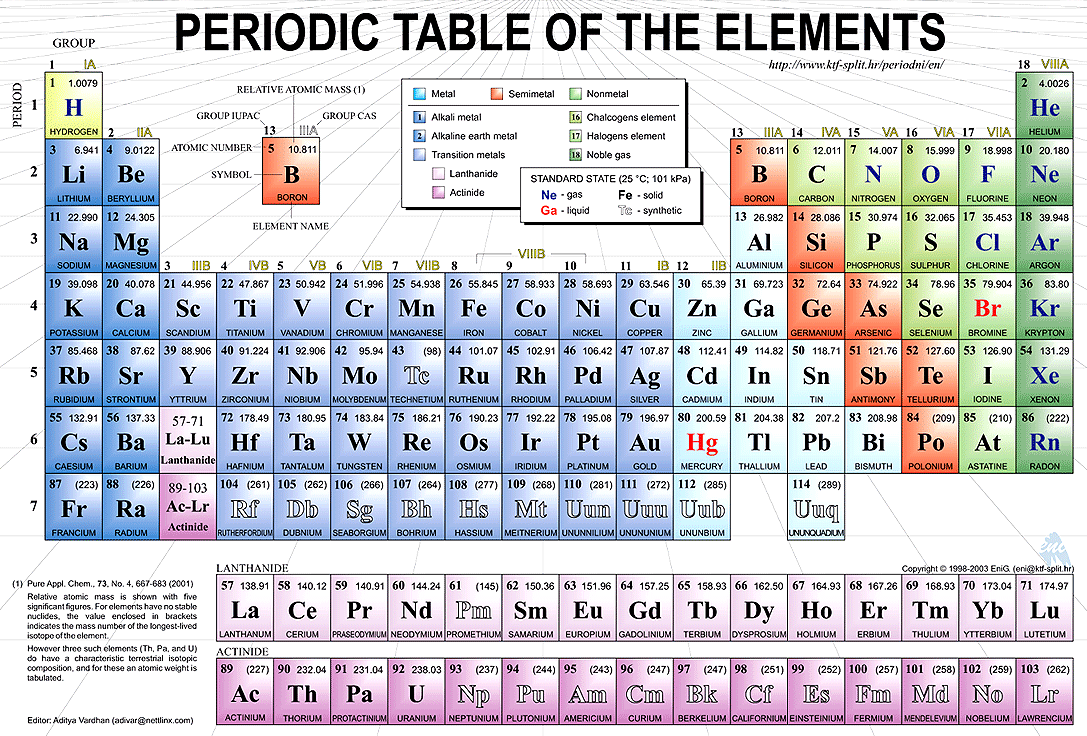
Meyer formed his periodic law based on the atomic volume or molar volume, which is the atomic mass divided by the density in solid form.

They both arranged the elements by their mass and proposed that certain properties periodically reoccur. Mendeleev created the first periodic table and was shortly followed by Meyer. The periodic law was developed independently by Dmitri Mendeleev and Lothar Meyer in 1869. Atomic Number as the Basis for the Periodic Law.This work was funded by the Department of Energy.\( \newcommand\) Other institutions that contributed to the research are the Colorado School of Mines, Bloomsburg University, Argonne National Laboratory, Oak Ridge National Laboratory, Institut National des Sciences Appliquées in France, University of Buffalo, Institut für Anorganische Chemie in Germany and the Los Alamos National Laboratory. Research for this publication spanned nine states and three countries. Researchers will be following up on this with work on additional berkelium compounds that they were able to make in the lab. “We had to capture the chemistry before nuclear decay destroyed the samples.” “Because it is so radioactive, there is never much available,” Albrecht-Schmitt said. The element reduces to half the amount in 320 days, at which point it is not stable enough for experiments. To run experiments though, he had to move quickly. The Department of Energy gave Albrecht-Schmitt 13 milligrams of berkelium, roughly 1,000 times more than anyone has used for a major research study. Related Article: Livermorium and Flerovium Join the Periodic Table of Elements His previous work showed that the element californium had unique properties and represented a break in the periodic table to a new kind of chemistry that had not been observed before. The department has also recently awarded him $10 million as part of its Energy Research Center program so he can investigate new technologies to recycle nuclear waste and cleanup Cold War-era weapon production sites. Because of this, the Department of Energy has worked with him extensively on research that illuminates the far regions of the periodic table.

His chemistry lab is specifically designed to handle radioactive elements like berkelium, making it the only university lab in the country equipped to do so. But little has been done to understand what the element alone can do and how it functions.Īlbrecht-Schmitt’s lab is a novelty in the world of university science. “We just saw these tiny crystals exploding.”īerkelium has been mostly used to help scientists synthesize new elements such as element 117, tennessine, which was added to the table earlier this year. The crystals Albrecht-Schmitt and his colleagues made developed such a positive nuclear charge that they started fragmenting shortly after they were assembled. “It’s electronically different than what people expected,” he said. Through this process, Albrecht-Schmitt found that that berkelium was very similar to its periodic table neighbor californium in its structure, but chemically it had some significant differences.
Periodic table chemistry lab series#
In a series of carefully choreographed experiments both at his specialized lab and at the FSU-based National High Magnetic Field Laboratory, Albrecht-Schmitt made a berkelium borate compound and a complex berkelium molecule in the form of crystals, and also completed a series of measurements of the element to better understand its structural and chemical similarities to surrounding elements such as californium (Cf) and Curium (Cm). These elements are some of the heaviest, yet least understood chemical elements on Earth. Even after having it for almost 70 years, many of the basic chemical properties are still unknown.”īerkelium, discovered in 1949, resides at the very end of the periodic table among a group of elements called the actinide series. “The purpose is to understand the underlying chemistry of the element.

“What this really gives us is an understanding of how chemistry is changing late in the table,” Albrecht-Schmitt said. Related Article: Provisional Names Announced for Superheavy Elements 113, 115, 117, and 118 In the latest edition of the journal Science, Florida State University Professor Thomas Albrecht-Schmitt captures the fundamental chemistry of the element berkelium, or Bk on the periodic table. (Tallahassee, FL)-A little known-and difficult to obtain-element on the fringes of the periodic table is broadening our fundamental understanding of chemistry. Photo Courtesy of: Bill Lax/Florida State University Professor Thomas Albrecht-Schmitt works with some of the heaviest elements in the periodic table.


 0 kommentar(er)
0 kommentar(er)
